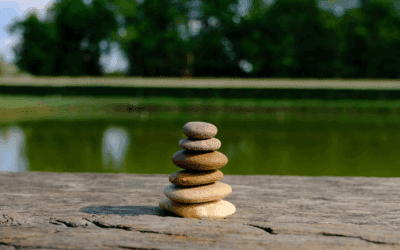There are so many styles of meditation and it is important to try several types before knowing what works best for you.
At our corporate silent retreats, we generally do silent meditation and guided meditation. If possible, we try to have the majority of the meditations at the retreats in silence. It is harder for the mind and body but gives a broader set of benefits.
Many times, while you meditate, thoughts that disturb you suddenly appear, to-do lists, uncertainty about the future etc.. The key is to let them pass as if they were clouds in the sky, without you controlling them, you see the thought and then let it go, just like a cloud.
These are the techniques that we use in our corporate silent retreats and that you can start practicing a few weeks before the trip if you prefer, and most importantly: keep doing it once the retreat is over.
The types of meditations we use in our silent retreats
The first thing to do is find a comfortable position, either sitting or leaning against a wall. You want to have your back slightly straight, with your hips higher than your knees and your hands on your knees and your facial expressions relaxed. It is best to avoid doing it completely lying down because you could fall asleep, and the goal is to stay awake and meditate!
Meditation with a candle:
If you focus on a specific point, it may be easier to calm your mind. We will light a candle and focus our gaze on it. Some people, when they close their eyes, feel that their mind is filled with images, faces of people and places appear suddenly and with them the tasks that we have pending and the plans to carry out. For this reason, it is easier for some people, to keep their eyes open and focus on a specific image, for example, a small lit candle, and in this way it is easier for them to meditate. You can also try to imagine that candle or focus on your favorite color, in any case, it is about focusing your mind on an object that makes you calm.
Meditation with a mantra:
Mantras are ancient sounds that were used in ancient times to meditate and according to the ancient Vedas of India, repeating a specific mantra will help our mind put aside the internal noise, become calm and be fully aware.
Om is the most important Mantra of all, originally appearing as a vibration in the Universe. The correct repetition of mantras connects us with the present moment. It helps us focus our attention so it is easier to meditate. Its practice fills us with good health and develops creativity.
“Man” means to think or a thought while “tra” refers to liberate or protect. This is why the translation of the word Mantra might be “liberating thought” or “protector”. The Mantra “protects” us from the constant mental fluctuations. In the majority of the cases these mental fluctuations cause stress and block the flow of energy in the body that can even cause disease.
Types of Mantras
Mantras Biya or Seed Mantra
They are normally letters or syllables. Even though they don’t mean anything, they are the most important. They act directly with the Nadis (channels of energy or literally channels of sound). An example of Mantra Biya is “Mantra Purusha”, that consists of 50 letters from the Sanskrit alphabet.
Mantras Saguna
These are mantras which are destined to one particular deity. Example: OM Aim Sarasvatiai Namah = Madre Sarasvati.
Mantras Nirguna or abstract Mantras
They are identified with eternal Creation. Example: SO HAM = I am. SO HAM is a very popular mantra to be used in seated meditation.
We invite you to watch the following video: Morning Vedic Mantras with Lyrics and Meaning – Most Effective & Powerful Mantras To Start the Day. This video has several mantras that you might enjoy.
Seated meditation with eyes closed:
In this case, simply close your eyes and breathe calmly. Try to let the thoughts pass one after another without concentrating on any of them. If you suddenly find yourself solving a pending issue, stop, be aware and return to the starting point. It helps to use some sort of anchor during the meditation this can be the breath, a mantra, or even concentrate on an object in your mind like the moon. Whenever your mind wanders go back to your anchor.
Not all meditation practices are perfect, there are moments more difficult than others, but it is worth the effort, your body and mind will feel renewed once you finish doing it.
Zen meditation with eyes open:
Zen meditation you keep your eyes slightly open fixated on one point on the floor or looking at the wall. Zen is divided into 3 parts, a seated portion, a shorter walking section and another seated meditation at the end. Sometimes you might break it up with 30min of seated, 10min of slow walking and another 30min seated. Some people really prefer to meditate with their eyes open as you are less likely to see visions or think as much. The walking helps for people that find one hour of seated meditation too long without movement. Often when you do Zen meditation you see colours, shades or even imaginary objects. You are supposed to ignore these things and stick to gazing at one point with your eyes slightly open. Zen meditation is a very popular form of meditation.
Guided meditation:
There are so many options in terms of guided meditation. Most guided meditations the facilitator is talking most of the time during the meditation. They follow a script generally relaxing the body first and then going to the breath and from there focusing on a specific topic such as: chakras, self-esteem, fear, relaxation to name a few. Guided meditations can also follow a story asking the listeners to imagine what the facilitator is saying. Some people find guided meditations easier as their minds are concentrating on something instead of just silence. Finding the right type of guided meditation that suits you and the correct voice giving the meditation is key.
There are multiple types of meditation here and we have only detailed the ones we do in our corporate silent retreats, but if you want to know more about the various practices we recommend the following book: Total Meditation: Practices in Living the Awakened Life by Deepak Chopra.
If you have any further questions about meditation and would like further assistance, please contact the Silent Focus team we are hear to help. You can also sign up to our newsletter below where we send out tips to stay mindful at work and recipes from our retreats.




